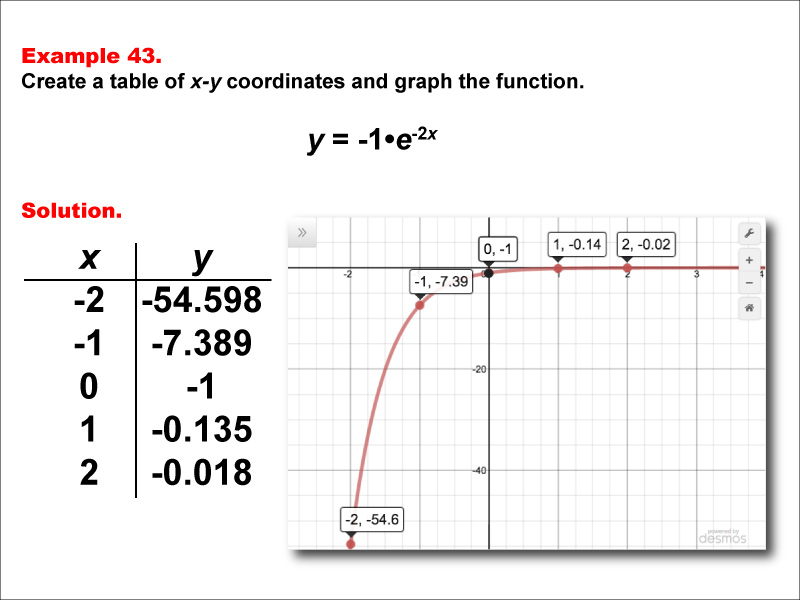
Display Title
Math Example--Exponential Concepts--Exponential Functions in Tabular and Graph Form: Example 43
Display Title
Math Example--Exponential Concepts--Exponential Functions in Tabular and Graph Form: Example 43

Topic
Exponential Functions
Description
This math example showcases the exponential function y = -1 * e-2x through a table of x-y coordinates and a corresponding graph. The table lists values for x ranging from -2 to 2, illustrating how the function's output changes rapidly as x increases. The graph provides a visual representation of this exponential growth function with a negative coefficient, emphasizing its unique shape and behavior.
Exponential functions with coefficients and exponents are crucial in mathematics and have wide-ranging applications in fields such as physics, biology, and economics. This collection of examples aids in teaching the topic by presenting students with various representations of exponential functions, allowing them to observe how different parameters affect the function's behavior. By examining both tabular and graphical forms of functions with negative coefficients and positive exponents, students can develop a deeper understanding of how these elements impact the overall shape and direction of the curve.
The importance of studying multiple worked-out examples cannot be overstated when learning about complex exponential functions. Each example in this set highlights a different aspect of exponential functions, helping students recognize patterns and understand how changes in the sign of the coefficient and the value of the exponent impact the function's graph and values. This variety of examples reinforces the concept and helps students build a more intuitive grasp of exponential behavior, preparing them to tackle more complex problems and real-world applications involving rapid exponential growth in various directions.
Teacher Script: "Now, let's analyze the function y = -1 * e-2x. Notice how this function decreases rapidly as x becomes negative, and increases rapidly in the negative direction as x becomes positive. The negative coefficient flips the graph vertically, while the factor of 2 in the exponent accelerates the growth rate compared to a standard exponential function. Compare this to our previous examples with positive coefficients. How does the combination of a negative coefficient and a doubled exponent affect the graph's shape and orientation? Can you think of any real-world phenomena that might be modeled by this type of rapidly growing, inverted exponential function?"
For a complete collection of math examples related to Exponential Functions click on this link: Math Examples: Exponential Functions Collection.
| Common Core Standards | CCSS.MATH.CONTENT.HSF.IF.C.7.E, CCSS.Math.CONTENT.HSF.LE.A.2, CCSS.MATH.CONTENT.HSF.LE.B.5 |
|---|---|
| Grade Range | 9 - 12 |
| Curriculum Nodes |
Algebra • Exponential and Logarithmic Functions • Graphs of Exponential and Logarithmic Functions |
| Copyright Year | 2015 |
| Keywords | function, graphs of exponential functions, exponential function tables |